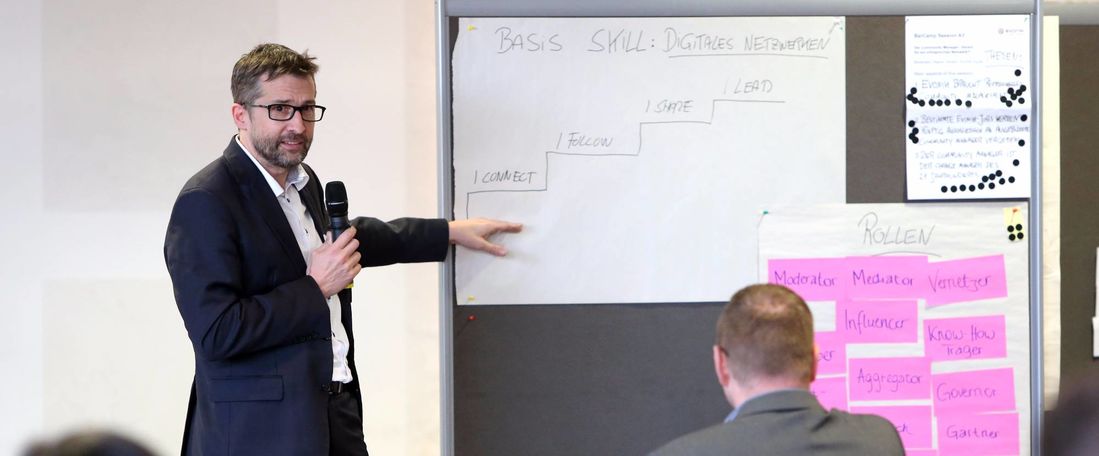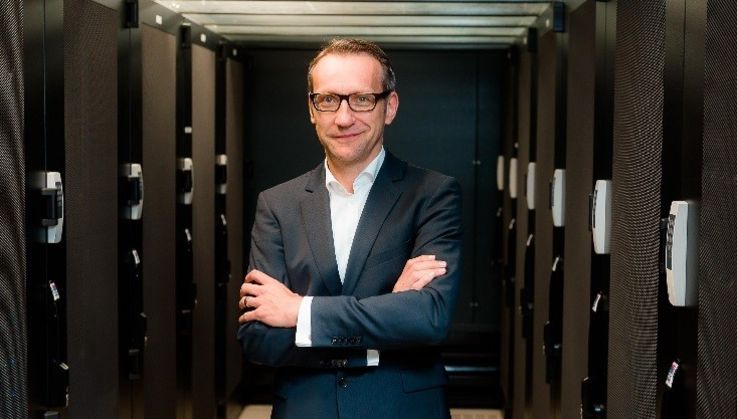
#EvonikDigital-Interview
“Network invitation instead of business cards”
Rainer Gimbel promotes cooperation in social networks at Evonik. In this interview, he explains how that works with the help of “Working Out Loud” and why it isn’t just important for work, but also a lot of fun.
Rainer, you have been driving the Group’s internal social network at Evonik for many years. In your work, you rely primarily on the method of “Working Out Loud” – can you explain what that is?
Basically, it is about using networks to share my knowledge and to benefit from shared knowledge myself. That means making my work accessible to others and publishing my findings–or sometimes just a draft. My colleagues can access this information as needed and can give me feedback.
To me, it is primarily a matter of a mindset that values generosity. I don’t expect anything in return for sharing my work. I don’t necessarily even have t[FAK1] o share information. I can also give attention, which in turn generates more attention, perhaps with someone who can help solve a problem or achieve a goal.
All of that sounds pretty much analog – what does it have to do with digitalization?
Digital technologies enable the establishment and maintenance of network opportunities that didn’t exist a few years ago. I can keep much larger networks and my contributions reach many more people via my network. The crux of the matter is to maintain these network contacts.
Do you have any tips for keeping your network alive?
As I mentioned earlier, one approach is to make your own work visible. To present results, or even interim findings, keeps others up-to-date.
Then there is also phatic communication. Hardly anyone knows what that means, but everyone is doing it. That includes, for example, sending a postcard when you are on vacation. Ultimately, that’s communication without significant information content that serves to maintain networks and contacts. The equivalent in the digital world would be, for example, a selfie from a seminar or posting about taking a trip to another work site. It keeps you visible in the network.
In addition, it is important to move past the boundaries of networks. Recommending or sharing posts allows my contacts to see contributions of other users that may not be part of their network. Interestingly, these are exactly the scenarios that generate innovation.

Photo: iStock / Kenishirotie
Do you have any examples of experiences you had with “Working Out Loud” so far?
Absolutely. Take the example of John Stepper, the inventor of the “Working Out Loud” learning method. When I read a public blog entry he had written on the topic of Working Out Loud in 2012, I thought, “Wow, this guy is a guru. What would he ever have to do with a regular guy like me?” Well, he came to visit us at Evonik Digital last May to give a keynote and a workshop for interested colleagues. He always asks me how my dancing is going because he remembers that I go out dancing with my wife every Friday.
The way this meeting developed could have been in a “Working Out Loud” textbook. I followed him on Twitter, then on LinkedIn, and I shared and commented on his posts every now and then. I showed him the attention that I mentioned earlier. He thanked me and we wrote back and forth. That’s how you build mutual trust and relationships – which is ultimately what it’s all about.
How can others learn this method?
In John Stepper’s method, colleagues can regularly share information in so-called circles for 12 weeks in a small group. The participants work through exercises for implementing Working Out Loud in practice.
And within the company?
I have been able to get to know many colleagues much better. It is incredibly interesting to see the people behind the business position. Who would have thought that one of our colleagues maintains a successful YouTube channel with 40,000 subscribers? I now know that we have colleagues at Evonik who write science fiction novels in their free time, while others are gifted painters or work as models. It’s a great chance to show off your own talents. That’s another purpose of “Working Out Loud”: Finding unused potentials beyond a job description, for yourself and others, which may help me or the company in the future.
How does that help with work?
Take the phrase "If Evonik only knew what Evonik knows” – it exemplifies what "Working Out Loud” could bring about: Making knowledge available, which takes the participation of as many people as possible. We used to exchange business cards at meetings in the past. Unfortunately, these contacts frequently ended up in a drawer. Instead of handing out a business card, today you invite someone to your network, which gives both sides the option to benefit from the contact.
What do you say to colleagues who are critical about the concept because they think, “I didn’t need that in the past 20 years – why would I need it in the upcoming 20?”
It is important to note that you can’t force anyone to take part in “Working Out Loud". Because the method requires active participation, it only works when someone is willing to engage. However, the following argument convinces many people: If I make my work and my knowledge available, meaning publicly accessible, I won’t have to answer the same questions dozens of times by e-mail or phone – which gives me more time for important things. And, if I make my work visible, the quality of my work is not just decided by my boss, but primarily by my network.
Speaking of publicly accessible and visible: Isn’t there a risk to disclose information that is not intended for the public?
Confidential matters must remain confidential – there is no question about that. Our concern is the approximately 80% information that is not confidential. When we generously share this knowledge, everyone benefits.



